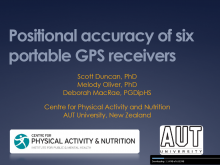We are pleased to announce an exciting new alliance between Active Living Research and GP RED to co-host and coordinate...
Positional Accuracy of Six Portable GPS Receivers

Presentation at the 2011 Active Living Research Annual Conference
Background: Portable global positioning system (GPS) receivers are an emerging technology for the objective assessment of spatial location. When combined with an instrument that measures physical activity, GPS receivers can provide essential information about how people interact with their environment. Despite the increasing popularity of GPS in active living research, the positional accuracy of current GPS receivers and how they are affected by a variety of environmental conditions is poorly understood.
Objectives: The primary objective of this study was to determine the positional accuracy of seven commonly used GPS receivers when subjected to a variety of environmental conditions. Secondary objectives were to determine the interunit reliability of the selected GPS receivers and to examine the accuracy of manufacturer specifications of battery life and initialisation/acquisition times.
Methods: Three individual units of each of the seven GPS receiver models (Garmin Etrex, Garmin Foretrex 201, Garmin Forerunner 205, Qstarz BT-Q1000XT, GlobalSat TR-203, FRWD B100, Telespial Trackstick II) were placed on five different geodetic points in Auckland, New Zealand, in clear weather conditions. The geodetic points were selected to replicate a variety of environmental conditions (open suburbia, proximal to cellular network antenna, under metal awning, under trees, urban canyon). Straight-line distance between the geodetic point and GPS-determined location was calculated for each time point over a 30-minute period. The mean error (± SD) for each GPS receiver model was compared across the five different settings. In addition, the interunit reliability of each receiver model was estimated by comparing the differences in distances within the three units of each model to the geodetic points. Finally, the observed maximum battery life and initialisation/acquisition times were compared to manufacturer specifications.
Results: Data acquisition was moderately better in the uncovered settings (suburbia, cell tower) when compared to the covered settings (trees, awning, urban canyon). In the uncovered settings, the selected GPS units failed to record useable data 16.7% of the time; this figure rose to 27.8% in covered settings. Of the units that recorded data, positional error was greatest and most variable under the metal awning (range: 17.3 ± 12.4 m to 701 ± 540 m) and in the urban canyon (range: 23.5 ± 7.93 m to 174 ± 18.2 m), whereas the open suburbia setting provided the best results (range: 3.92 ± 2.47 m to 11.5 ± 7.14 m). The performance of the GPS models varied considerably, with the best averaging 16.4 ± 15.1 m over the five settings and the worst averaging 330 ± 304 m.1 Interunit reliability was also highly variable from model to model, ranging from less than a metre to tens of metres, depending on the nature of the setting. Finally, our observations suggest that the battery life and initialisation/acquisition time may be over- and under-estimated (respectively) in the product specifications of several GPS models.
Conclusions: Given the increasing popularity of off-the-shelf GPS units for active living research, it is essential that we have an understanding of the accuracy of the instruments under a variety of ‘typical’ environments. Our results show that the coordinates provided by some GPS units can be inaccurate by hundreds of metres in certain outdoor conditions. Furthermore, some portable GPS models perform consistently better than others regardless of the setting. These results suggest that researchers should take care when choosing a portable GPS receiver to ensure they are able to provide acceptable levels of accuracy and reliability under a variety of environmental conditions.
1Given the potential commercial impact of these results for the manufacturers of the selected GPS receivers, we have decided to refrain from listing specific performance and reliability rankings until we have replicated the study in September 2010.
STAY UP TO DATE
RECENTLY ADDED TOOLS & RESOURCES
MOVE! A BLOG ABOUT ACTIVE LIVING
The "Active Living Conference" aims to break down research and practice silos and...







